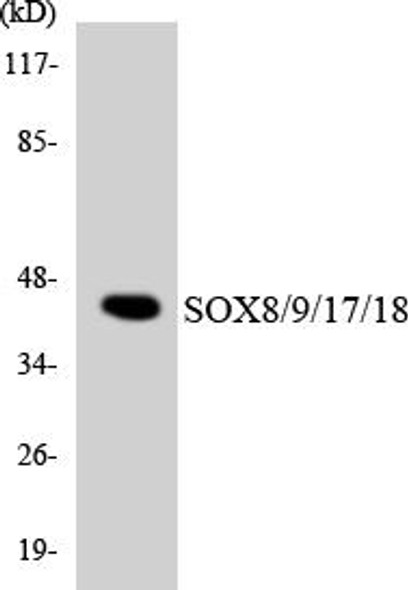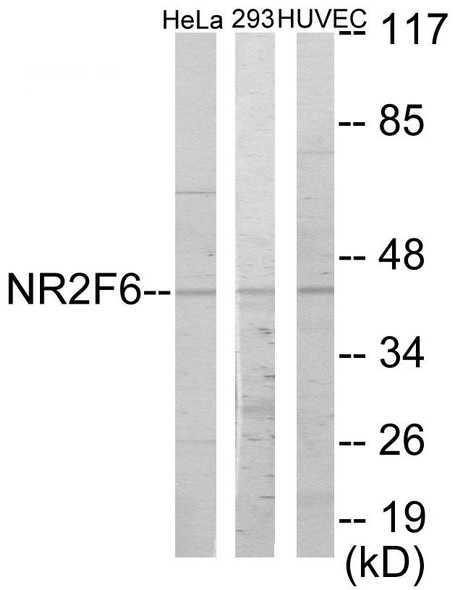Description
TBX15/18 Colorimetric Cell-Based ELISA
The TBX15 (T-Box 15) Colorimetric Cell-Based ELISA Kit from AssayGenie is a cutting-edge tool for the accurate measurement of TBX15 levels in cell lysates and tissue samples. This innovative kit boasts high sensitivity and specificity, allowing for precise and dependable results in a variety of experimental settings.TBX15 is a transcription factor that plays a critical role in regulating developmental processes such as limb and kidney development.
Dysregulation of TBX15 has been implicated in various diseases, including obesity, diabetes, and cancer, making it a key target for further investigation and therapeutic development.With the AssayGenie TBX15 Colorimetric Cell-Based ELISA Kit, researchers can delve deeper into the mechanisms underlying TBX15 function and its implications for human health. Trust in AssayGenie for top-quality assays that push the boundaries of scientific discovery.
| Product Name: | TBX15/18 Colorimetric Cell-Based ELISA |
| Product Code: | CBCAB00966 |
| ELISA Type: | Cell-Based |
| Target: | TBX15/18 |
| Reactivity: | Human, Mouse |
| Dynamic Range: | > 5000 Cells |
| Detection Method: | Colorimetric 450 nmStorage/Stability:4°C/6 Months |
| Format: | 96-Well Microplate |
The TBX15/18 Colorimetric Cell-Based ELISA Kit is a convenient, lysate-free, high throughput and sensitive assay kit that can detect TBX15/18 protein expression profile in cells. The kit can be used for measuring the relative amounts of TBX15/18 in cultured cells as well as screening for the effects that various treatments, inhibitors (ie siRNA or chemicals), or activators have on TBX15/18.
Qualitative determination of TBX15/18 concentration is achieved by an indirect ELISA format. In essence, TBX15/18 is captured by TBX15/18-specific primary antibodies while the HRP-conjugated secondary antibodies bind the Fc region of the primary antibody. Through this binding, the HRP enzyme conjugated to the secondary antibody can catalyze a colorimetric reaction upon substrate addition. Due to the qualitative nature of the Cell-Based ELISA, multiple normalization methods are needed:
| 1. | A monoclonal antibody specific for human GAPDH is included to serve as an internal positive control in normalizing the target absorbance values. |
| 2. | Following the colorimetric measurement of HRP activity via substrate addition, the Crystal Violet whole-cell staining method may be used to determine cell density. After staining, the results can be analysed by normalizing the absorbance values to cell amounts, by which the plating difference can be adjusted. |
| Database Information: | Gene ID: 9096, UniProt ID: O95935/Q96SF7, OMIM: 604613/260660/604127, Unigene: Hs.251830/Hs.146196 |
| Gene Symbol: | TBX18 |
| Sub Type: | None |
| UniProt Protein Function: | TBX18: Probable transcriptional regulator involved in developmental processes. |
| UniProt Protein Details: | Protein type:Transcription factor; DNA-binding Chromosomal Location of Human Ortholog: 6q14-q15 Cellular Component: nucleus Molecular Function:protein binding; protein heterodimerization activity; protein homodimerization activity; transcription factor activity Biological Process: anterior/posterior axis specification; morphogenesis of embryonic epithelium; negative regulation of transcription from RNA polymerase II promoter; positive regulation of cell-cell adhesion; positive regulation of epithelial cell proliferation; sensory perception of sound; smooth muscle cell differentiation; somitogenesis; transcription, DNA-dependent Disease: Huntington Disease |
| NCBI Summary: | This genes codes for a member of an evolutionarily conserved family of transcription factors that plays a crucial role in embryonic development. The family is characterized by the presence of the DNA-binding T-box domain and is divided into five sub-families based on sequence conservation in this domain. The encoded protein belongs to the vertebrate specific Tbx1 sub-family. The protein acts as a transcriptional repressor by antagonizing transcriptional activators in the T-box family. The protein forms homo- or heterodimers with other transcription factors of the T-box family or other transcription factors. [provided by RefSeq, Nov 2012] |
| UniProt Code: | O95935 |
| NCBI GenInfo Identifier: | 122937456 |
| NCBI Gene ID: | 9096 |
| NCBI Accession: | NP_001073977.1 |
| UniProt Secondary Accession: | O95935,Q7Z6U4, Q9UJI6, A2RU13, |
| UniProt Related Accession: | O95935 |
| Molecular Weight: | 80.8 kDa |
| NCBI Full Name: | T-box transcription factor TBX18 |
| NCBI Synonym Full Names: | T-box 18 |
| NCBI Official Symbol: | TBX18 |
| NCBI Protein Information: | T-box transcription factor TBX18 |
| UniProt Protein Name: | T-box transcription factor TBX18 |
| Protein Family: | T-box transcription factor |
| UniProt Gene Name: | TBX18 |
| UniProt Entry Name: | TBX18_HUMAN |
| Component | Quantity |
| 96-Well Cell Culture Clear-Bottom Microplate | 2 plates |
| 10X TBS | 24 mL |
| Quenching Buffer | 24 mL |
| Blocking Buffer | 50 mL |
| 15X Wash Buffer | 50 mL |
| Primary Antibody Diluent | 12 mL |
| 100x Anti-Phospho Target Antibody | 60 µL |
| 100x Anti-Target Antibody | 60 µL |
| Anti-GAPDH Antibody | 60 µL |
| HRP-Conjugated Anti-Rabbit IgG Antibody | 12 mL |
| HRP-Conjugated Anti-Mouse IgG Antibody | 12 mL |
| SDS Solution | 12 mL |
| Stop Solution | 24 mL |
| Ready-to-Use Substrate | 12 mL |
| Crystal Violet Solution | 12 mL |
| Adhesive Plate Seals | 2 seals |
The following materials and/or equipment are NOT provided in this kit but are necessary to successfully conduct the experiment:
- Microplate reader able to measure absorbance at 450 nm and/or 595 nm for Crystal Violet Cell Staining (Optional)
- Micropipettes with capability of measuring volumes ranging from 1 µL to 1 ml
- 37% formaldehyde (Sigma Cat# F-8775) or formaldehyde from other sources
- Squirt bottle, manifold dispenser, multichannel pipette reservoir or automated microplate washer
- Graph paper or computer software capable of generating or displaying logarithmic functions
- Absorbent papers or vacuum aspirator
- Test tubes or microfuge tubes capable of storing ≥1 ml
- Poly-L-Lysine (Sigma Cat# P4832 for suspension cells)
- Orbital shaker (optional)
- Deionized or sterile water
*Note: Protocols are specific to each batch/lot. For the correct instructions please follow the protocol included in your kit.
| Step | Procedure |
| 1. | Seed 200 µL of 20,000 adherent cells in culture medium in each well of a 96-well plate. The plates included in the kit are sterile and treated for cell culture. For suspension cells and loosely attached cells, coat the plates with 100 µL of 10 µg/ml Poly-L-Lysine (not included) to each well of a 96-well plate for 30 minutes at 37°C prior to adding cells. |
| 2. | Incubate the cells for overnight at 37°C, 5% CO2. |
| 3. | Treat the cells as desired. |
| 4. | Remove the cell culture medium and rinse with 200 µL of 1x TBS, twice. |
| 5. | Fix the cells by incubating with 100 µL of Fixing Solution for 20 minutes at room temperature. The 4% formaldehyde is used for adherent cells and 8% formaldehyde is used for suspension cells and loosely attached cells. |
| 6. | Remove the Fixing Solution and wash the plate 3 times with 200 µL 1x Wash Buffer for five minutes each time with gentle shaking on the orbital shaker. The plate can be stored at 4°C for a week. |
| 7. | Add 100 µL of Quenching Buffer and incubate for 20 minutes at room temperature. |
| 8. | Wash the plate 3 times with 1x Wash Buffer for 5 minutes each time. |
| 9. | Add 200 µL of Blocking Buffer and incubate for 1 hour at room temperature. |
| 10. | Wash 3 times with 200 µL of 1x Wash Buffer for 5 minutes each time. |
| 11. | Add 50 µL of 1x primary antibodies (Anti-TBX15/18 Antibody and/or Anti-GAPDH Antibody) to the corresponding wells, cover with Parafilm and incubate for 16 hours (overnight) at 4°C. If the target expression is known to be high, incubate for 2 hours at room temperature. |
| 12. | Wash 3 times with 200 µL of 1x Wash Buffer for 5 minutes each time. |
| 13. | Add 50 µL of 1x secondary antibodies (HRP-Conjugated AntiRabbit IgG Antibody or HRP-Conjugated Anti-Mouse IgG Antibody) to corresponding wells and incubate for 1.5 hours at room temperature. |
| 14. | Wash 3 times with 200 µL of 1x Wash Buffer for 5 minutes each time. |
| 15. | Add 50 µL of Ready-to-Use Substrate to each well and incubate for 30 minutes at room temperature in the dark. |
| 16. | Add 50 µL of Stop Solution to each well and read OD at 450 nm immediately using the microplate reader. |
(Additional Crystal Violet staining may be performed if desired – details of this may be found in the kit technical manual.)






